Investigation into Off-Design Performance of a S-CO2 Turbine Based on Concentrated Solar Power
Abstract
:1. Introduction
2. Research Object
2.1. Impeller
2.2. Three Types of Nozzle
3. Numerical Method
3.1. Governing Equations and Boundary Conditions
3.2. Implementation of Fluid Properties
4. Results and Discussion
4.1. Off-Design Performance of Different LED
4.2. Aerodynamic Characteristics on Design Condition with Different LED
4.3. Off-Design Performance of the S-CO2 Turbine with Different LED
5. Conclusions
- (1)
- The reduction of inlet temperature has great influence on the aerodynamic performance. Taking LED = 7 mm as a representative, when the inlet temperature is below 400 K, the pressure distribution is disorderly and unsystematic, which indicates the low power capacity of the turbine.
- (2)
- Under design condition, when LED = 10 mm, the acceleration caused by the nozzle is the most effective and the turbine owns the most efficient power capacity. Meanwhile, the trans-critical area at the trailing edge of the impeller blade is the smallest. Hence, the turbine with nozzle LED = 10 mm owns the most stable operation characteristic.
- (3)
- When LED = 4 mm, the mass flow and output power is the largest since the nozzle flow passage obtains the largest flow area. For off-design conditions, when the inlet temperature further decreases below 400 K, the flow congestion arises. Comparing three different LEDs, the decrease of temperature has the lowest effect on the largest LED while the increase of temperature has the larger impact on the larger LED. When LED = 10 mm, the isentropic efficiency is slightly better while LED = 4 mm has the largest mass flow and power capacity. In a S-CO2 power system, larger mass flow rate will cause extra compression work in the compressor. Hence, for the selection of LED, one should consider both the efficiency and output power of the turbine and the compression work caused by larger mass flow rate, in order to obtain a best efficiency of the CSP power net, especially when the heat source of the net is of drastic change.
Author Contributions
Funding
Conflicts of Interest
References
- Gil, L.; Otin, S.F.; Embid, J.M.; Gallardo, M.A.; Blanco, S.; Artal, M.; Velasco, I. Experimental setup to measure critical properties of pure and binary mixtures and their densities at different pressures and temperatures Determination of the precision and uncertainty in the results. J. Supercrit. Fluids 2008, 44, 123–138. [Google Scholar] [CrossRef]
- Crespi, F.; Gavagnin, G.; Sanchez, D.; Martinez, G.S. Supercritical carbon dioxide cycles for power generation: A review. Appl. Energy 2017, 195, 152–183. [Google Scholar] [CrossRef]
- Mecheri, M.; Le Moullec, Y. Supercritical CO2 Brayton cycles for coal-fired power plants. Energy 2016, 103, 758–771. [Google Scholar] [CrossRef]
- Garg, P.; Kumar, P.; Srinivasan, K. Supercritical carbon dioxide Brayton cycle for concentrated solar power. J. Supercrit. Fluids 2013, 76, 54–60. [Google Scholar] [CrossRef]
- Ahn, Y.; Bae, S.J.; Kim, M.; Cho, S.K.; Baik, S.; Lee, J.I.; Cha, J.E. Review of supercritical CO2 power cycle technology and current status of research and development. Nucl. Eng. Technol. 2015, 47, 647–661. [Google Scholar] [CrossRef]
- Chen, M.-F.; Yamaguchi, H.; Zhang, X.-W.; Niu, X.-D. Performance analyses of a particularly designed turbine for a supercritical CO2-based solar Rankine cycle system. Int. J. Energy Res. 2015, 39, 1819–1827. [Google Scholar] [CrossRef]
- Osorio, J.D.; Hovsapian, R.; Ordonez, J.C. Dynamic analysis of concentrated solar supercritical CO2-based power generation closed-loop cycle. Appl. Therm. Eng. 2016, 93, 920–934. [Google Scholar] [CrossRef]
- Luu, M.T.; Milani, D.; McNaughton, R.; Abbas, A. Analysis for flexible operation of supercritical CO2 Brayton cycle integrated with solar thermal systems. Energy 2017, 124, 752–771. [Google Scholar] [CrossRef]
- Monje, B.; Sanchez, D.; Savill, M.; Pilidis, P.; Sanchez, T.; ASME. A Design Strategy for Supercritical CO2 Compressors; V03bt36a003; American Society of Mechanical Engineers: New York, NY, USA, 2014. [Google Scholar]
- Lopez, A.; Monje, B.; Sanchez, D.; Chacartegul, R.; Sanchez, T.; ASME. Effect of Turbulence and Flow Distortion on the Performance of Conical Diffusers Operating on Supercritical Carbon Dioxide; V008t34a002; American Society of Mechanical Engineers: New York, NY, USA, 2013. [Google Scholar]
- Valdes, M.; Abbas, R.; Rovira, A.; Martin-Aragon, J. Thermal efficiency of direct, inverse and sCO2 gas turbine cycles intended for small power plants. Energy 2016, 100, 66–72. [Google Scholar] [CrossRef]
- Zhang, H.Z.; Zhao, H.; Deng, Q.H.; Feng, Z.P.; ASME. Aerothermodynamic Design and Numerical Investigation of Supercritical Carbon Dioxide Turbine; UNSP v009t36a007; American Society of Mechanical Engineers: New York, NY, USA, 2015. [Google Scholar]
- Wang, X.R.; Wang, J.F.; Zhao, P.; Dai, Y.P. Thermodynamic Comparison and Optimization of Supercritical CO2 Brayton Cycles with a Bottoming Transcritical CO2 Cycle. J. Energy Eng. ASCE 2016, 142. [Google Scholar] [CrossRef]
- Iverson, B.D.; Conboy, T.M.; Pasch, J.J.; Kruizenga, A.M. Supercritical CO2 Brayton cycles for solar-thermal energy. Appl. Energy 2013, 111, 957–970. [Google Scholar] [CrossRef]
- Binotti, M.; Astolfi, M.; Campanari, S.; Manzolini, G.; Silva, P. Preliminary assessment of sCO2 power cycles for application to CSP Solar Tower plants. In Proceedings of the 8th International Conference on Applied Energy, Beijing, China, 8–11 October 2016; Yan, J., Sun, F., Chou, S.K., Desideri, U., Li, H., Campana, P., Xiong, R., Eds.; Elsevier Science BV: Amsterdam, The Netherlands, 2016; Volume 105, pp. 1116–1122. [Google Scholar]
- Kouta, A.; Al-Sulaiman, F.A.; Atif, M. Energy analysis of a solar driven cogeneration system using supercritical CO2 power cycle and MEE-TVC desalination system. Energy 2017, 119, 996–1009. [Google Scholar] [CrossRef]
- Hakkarainen, E.; Sihvonen, T.; Lappalainen, J. Dynamic Modelling and Simulation of CSP Plant Based on Supercritical Carbon Dioxide Closed Brayton Cycle. In International Conference on Concentrating Solar Power and Chemical Energy Systems; AlObaidli, A., Calvet, N., Richter, C., Eds.; American Institute of Physics: Melville, NY, USA, 2017; Volume 1850. [Google Scholar]
- Shi, D.B.; Li, L.L.; Zhang, Y.Y.; Xie, Y.H. Thermodynamic Design and Aerodynamic Analysis of Supercritical Carbon Dioxide Turbine. In Proceedings of the 2015 International Conference on Electromechanical Control Technology and Transportation, Zhuhai, China, 31 October–1 November 2015; Shyu, Y.H., Zhang, Y., Eds.; Atlantis Press: Paris, France, 2015; Volume 41, pp. 41–44. [Google Scholar]
- Menter, F.R. 2-Equation eddy-viscosity turbulence models for engineering applications. AIAA J. 1994, 32, 1598–1605. [Google Scholar] [CrossRef]
- Daabo, A.M.; Al Jubori, A.; Mahmoud, S.; Al-Dadah, R.K. Development of three-dimensional optimization of a small-scale radial turbine for solar powered Brayton cycle application. Appl. Therm. Eng. 2017, 111, 718–733. [Google Scholar] [CrossRef]
- Kim, S.G.; Lee, J.; Ahn, Y.; Lee, J.I.; Addad, Y.; Ko, B. CFD investigation of a centrifugal compressor derived from pump technology for supercritical carbon dioxide as a working fluid. J. Supercrit. Fluids 2014, 86, 160–171. [Google Scholar] [CrossRef]
- Odabaee, M.; Sauret, E.; Hooman, K. CFD Simulation of a Supercritical Carbon Dioxide Radial-Inflow Turbine, Comparing the Results of Using Real Gas Equation of Estate and Real Gas Property File. Appl. Mech. Mater. 2016, 846, 85–90. [Google Scholar] [CrossRef]
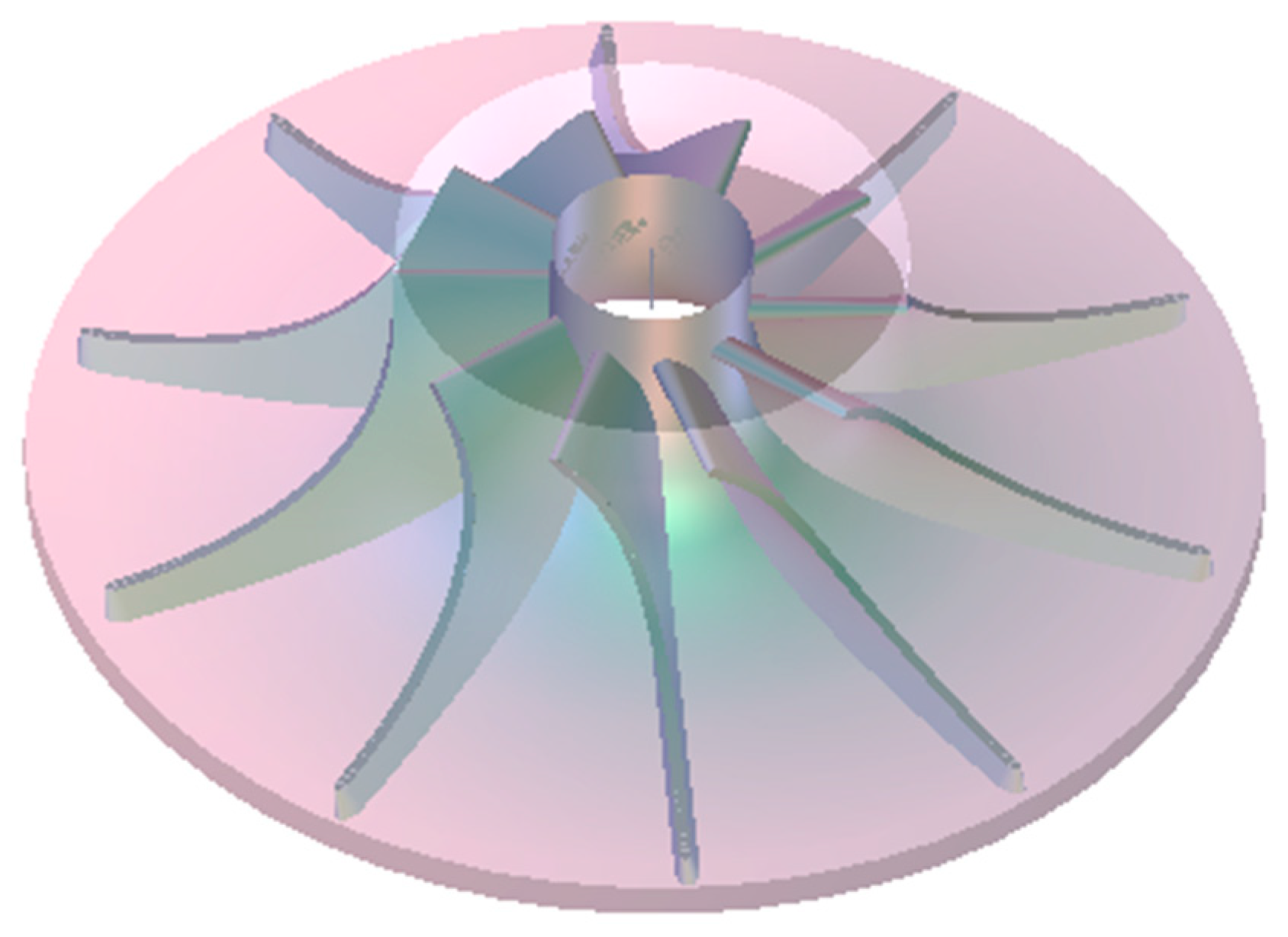

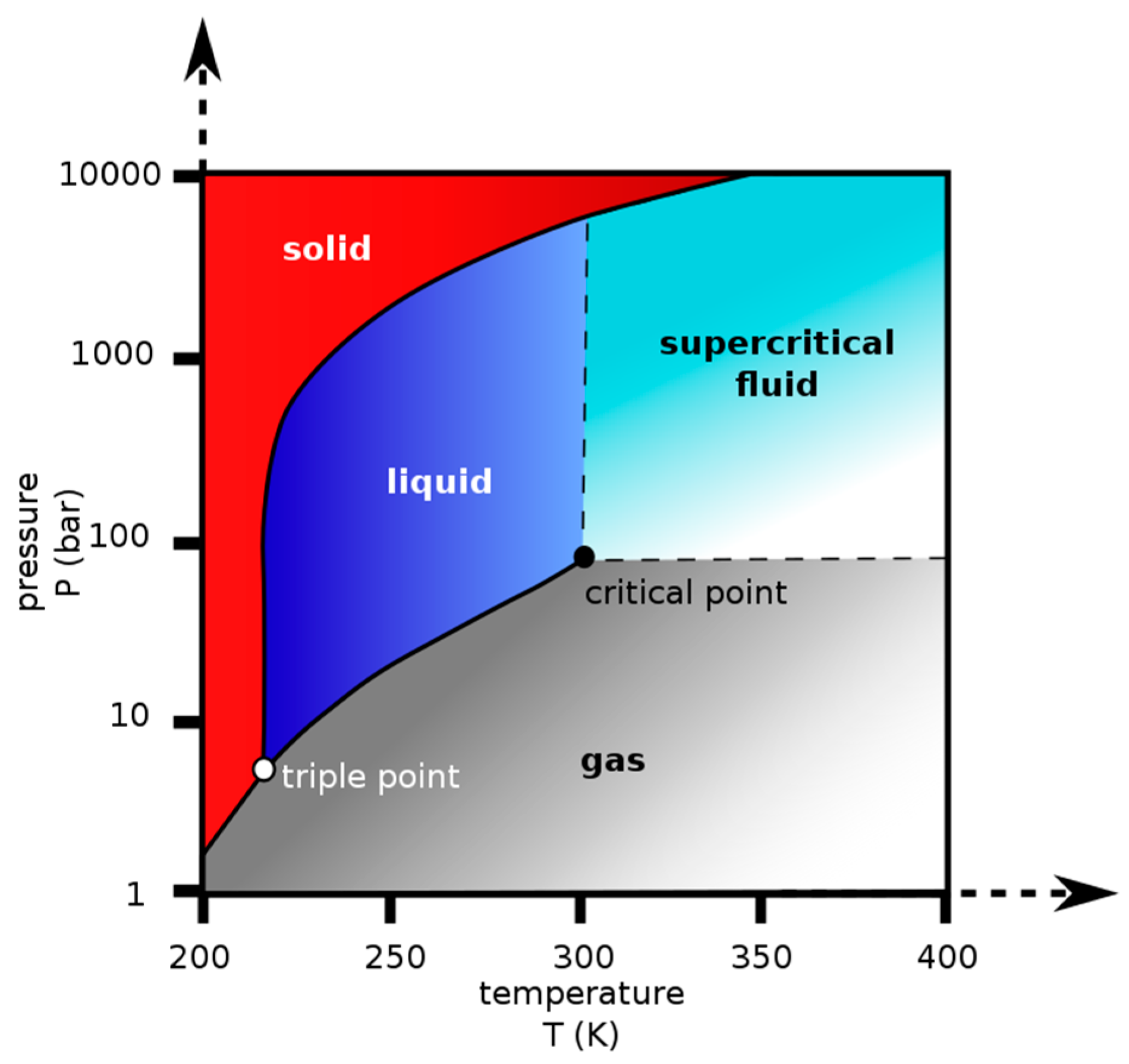
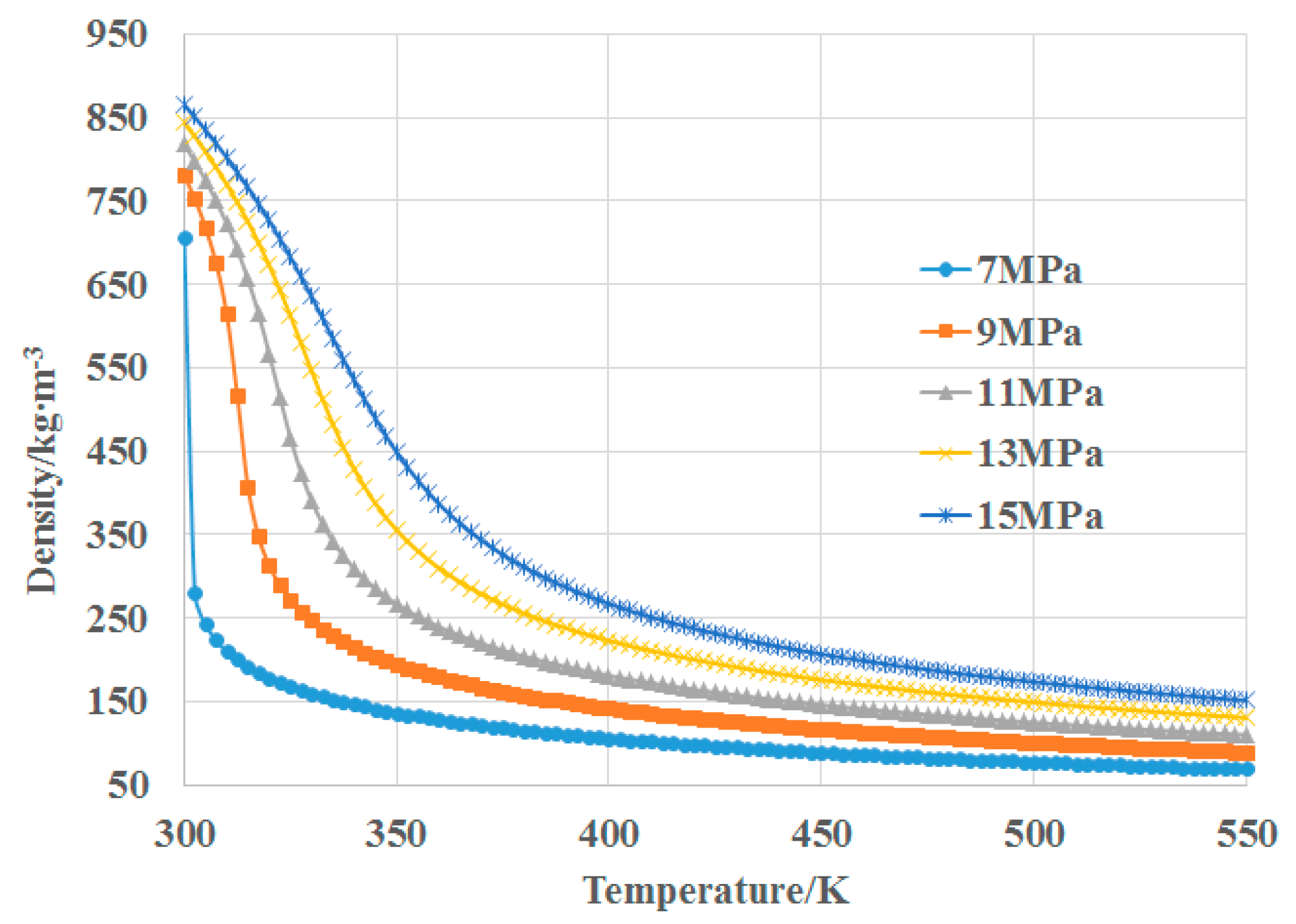


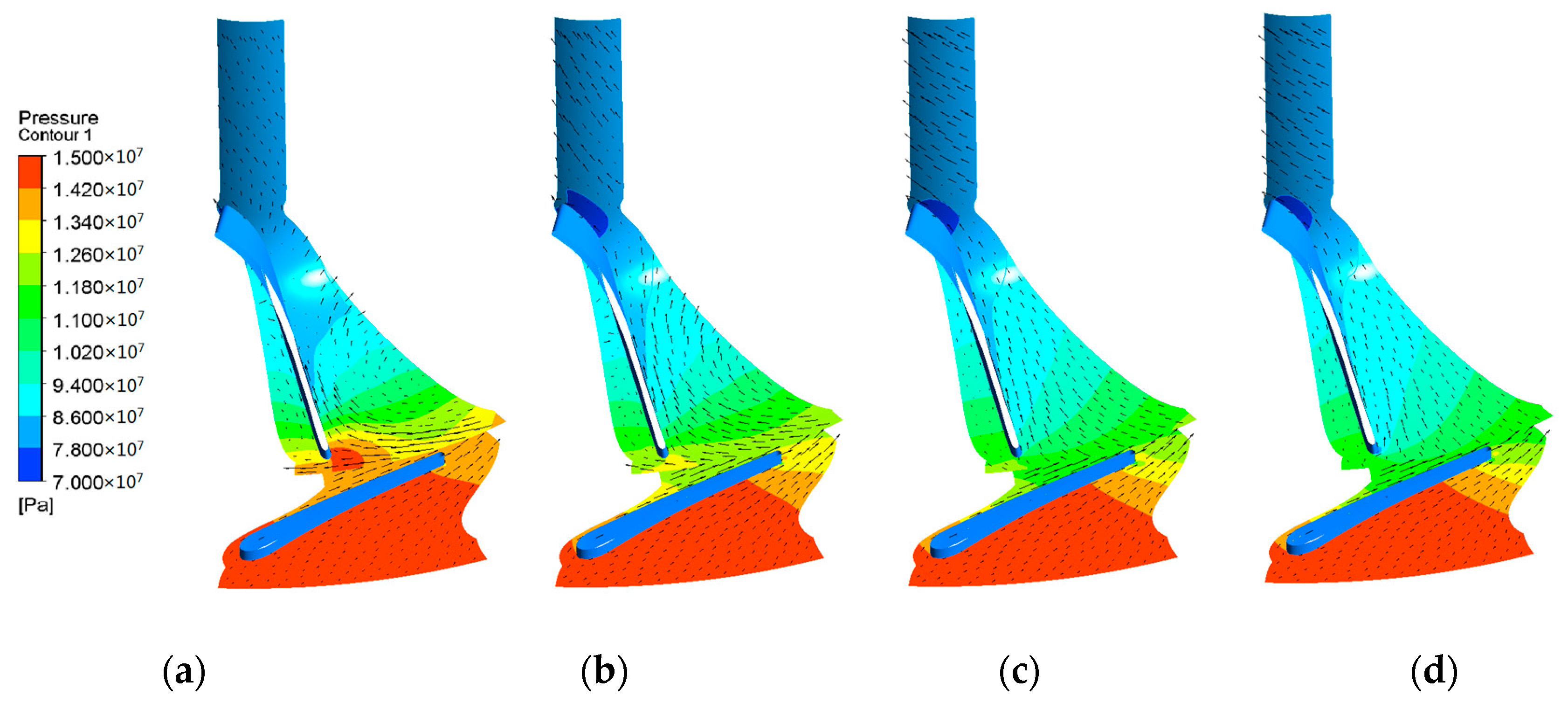
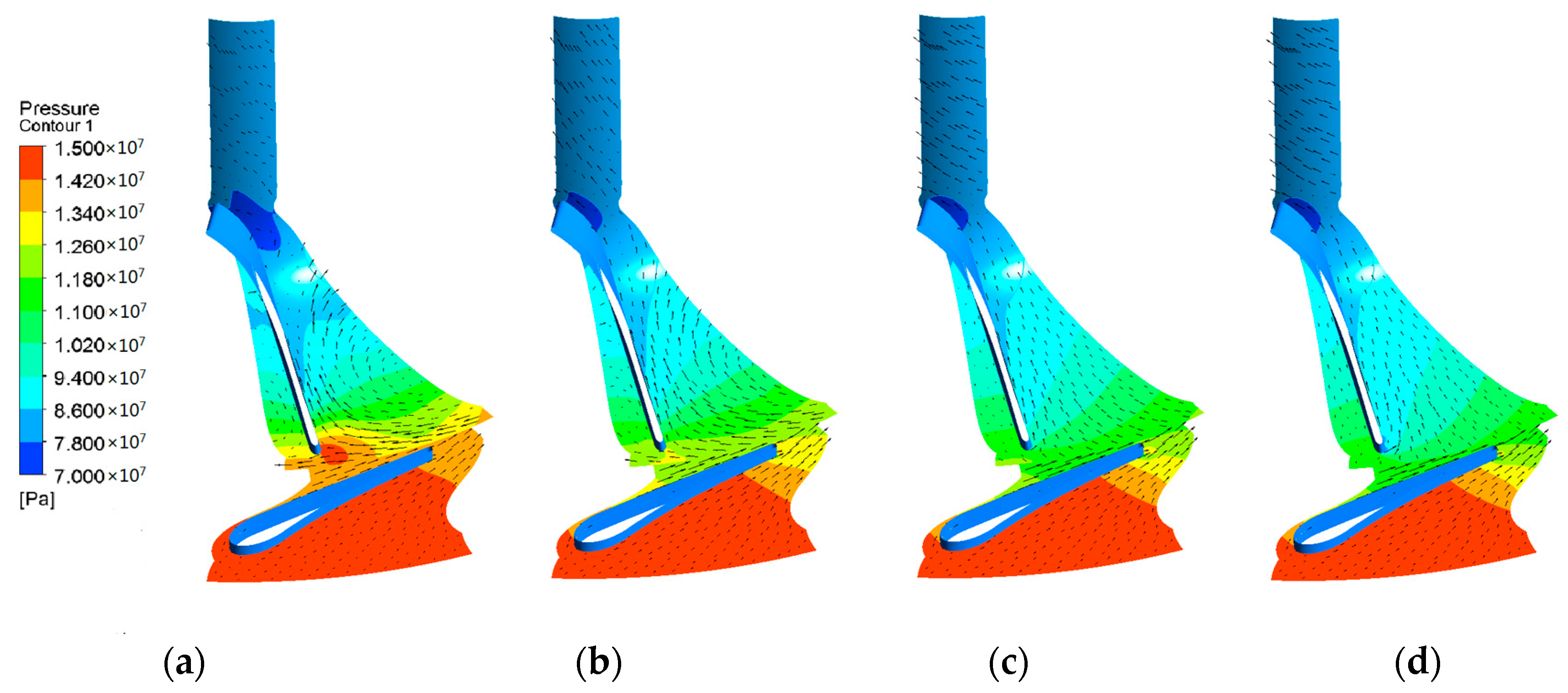
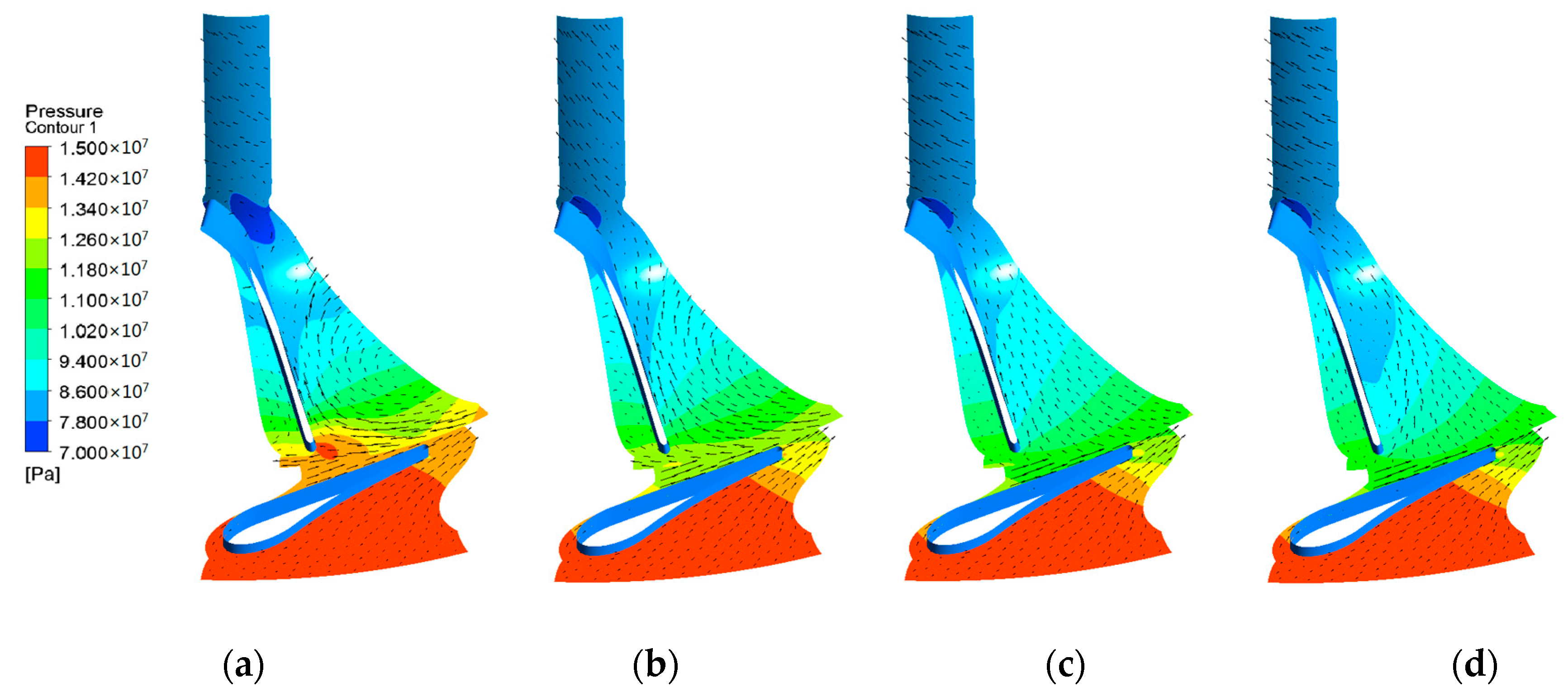
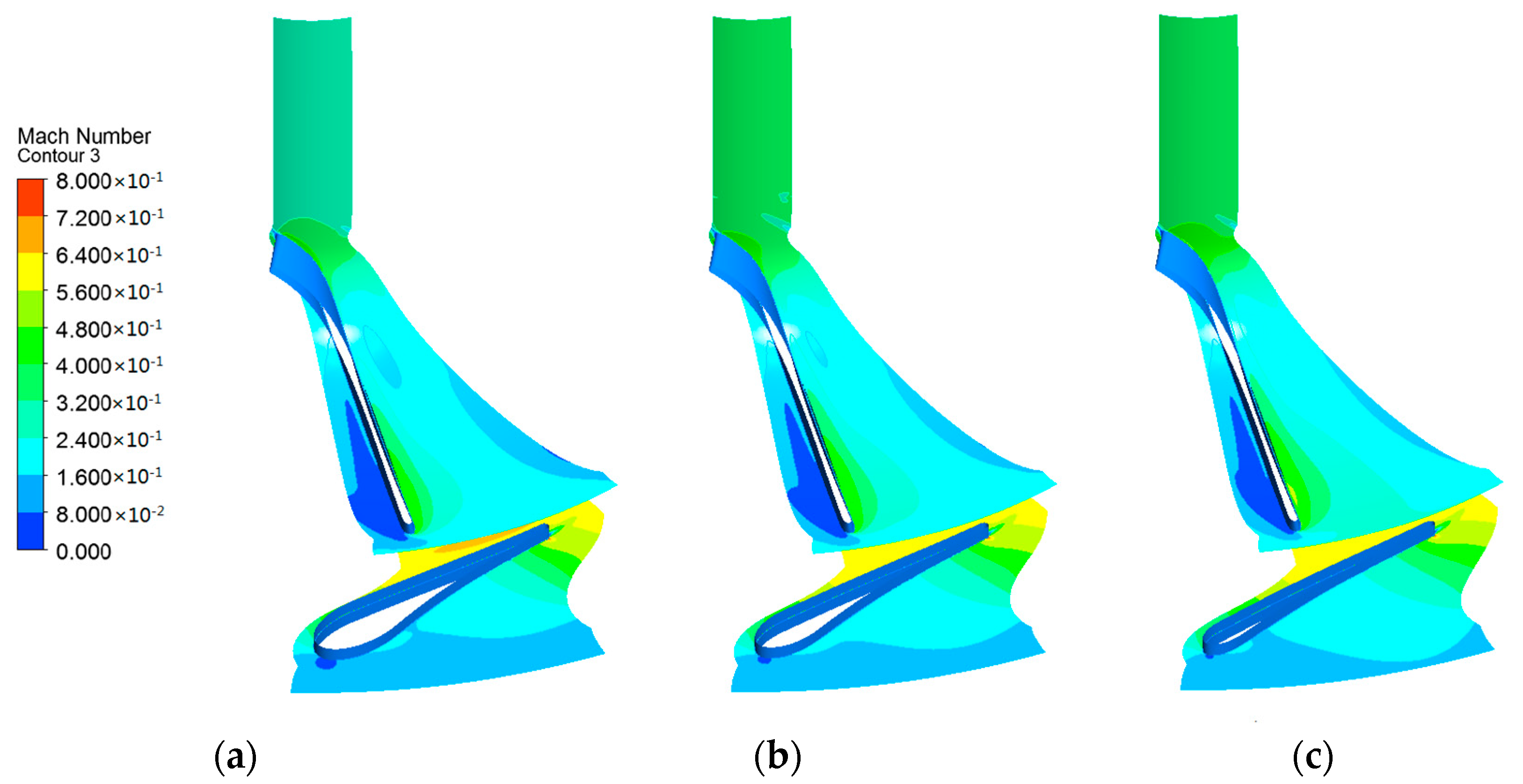
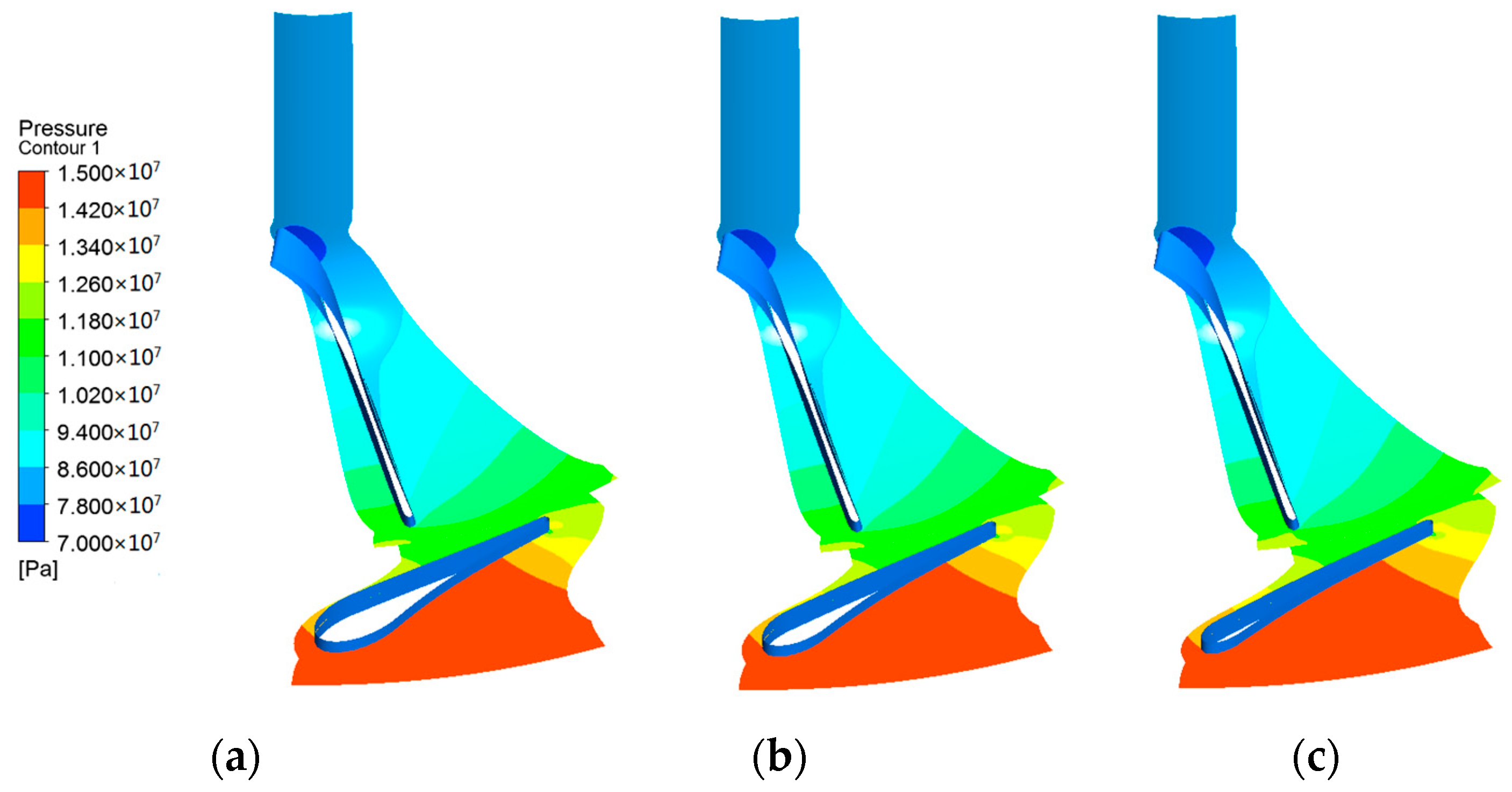
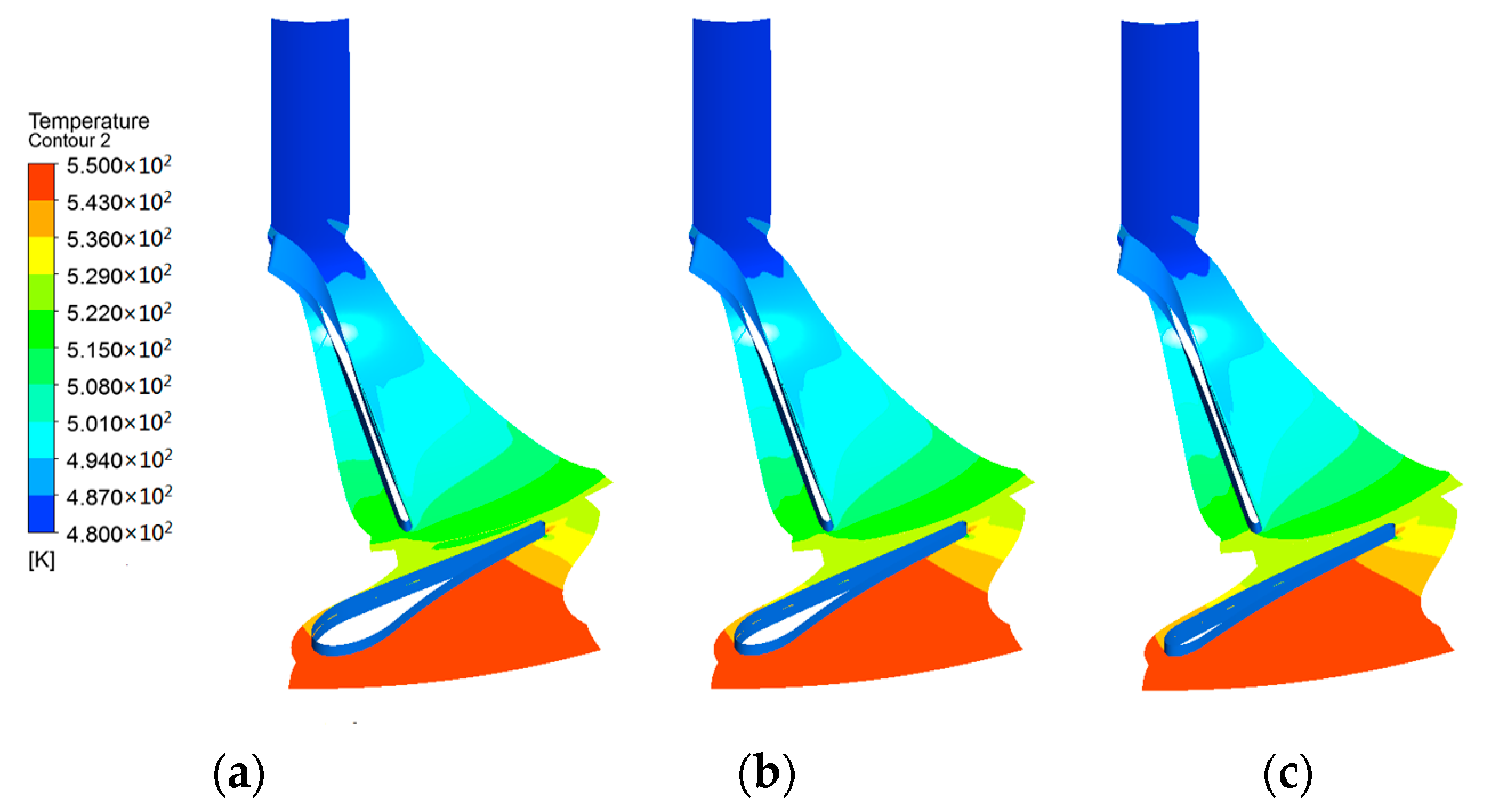
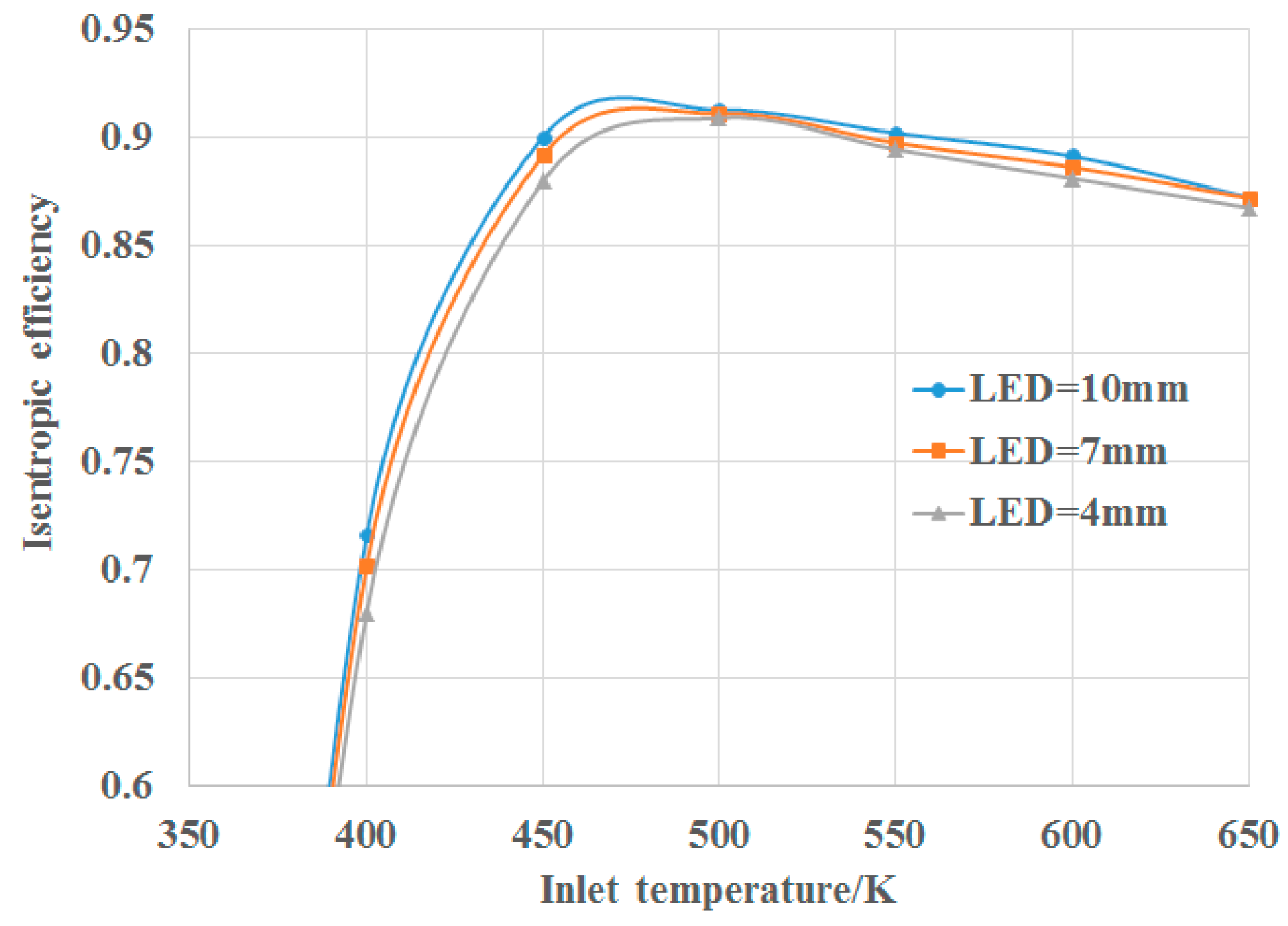

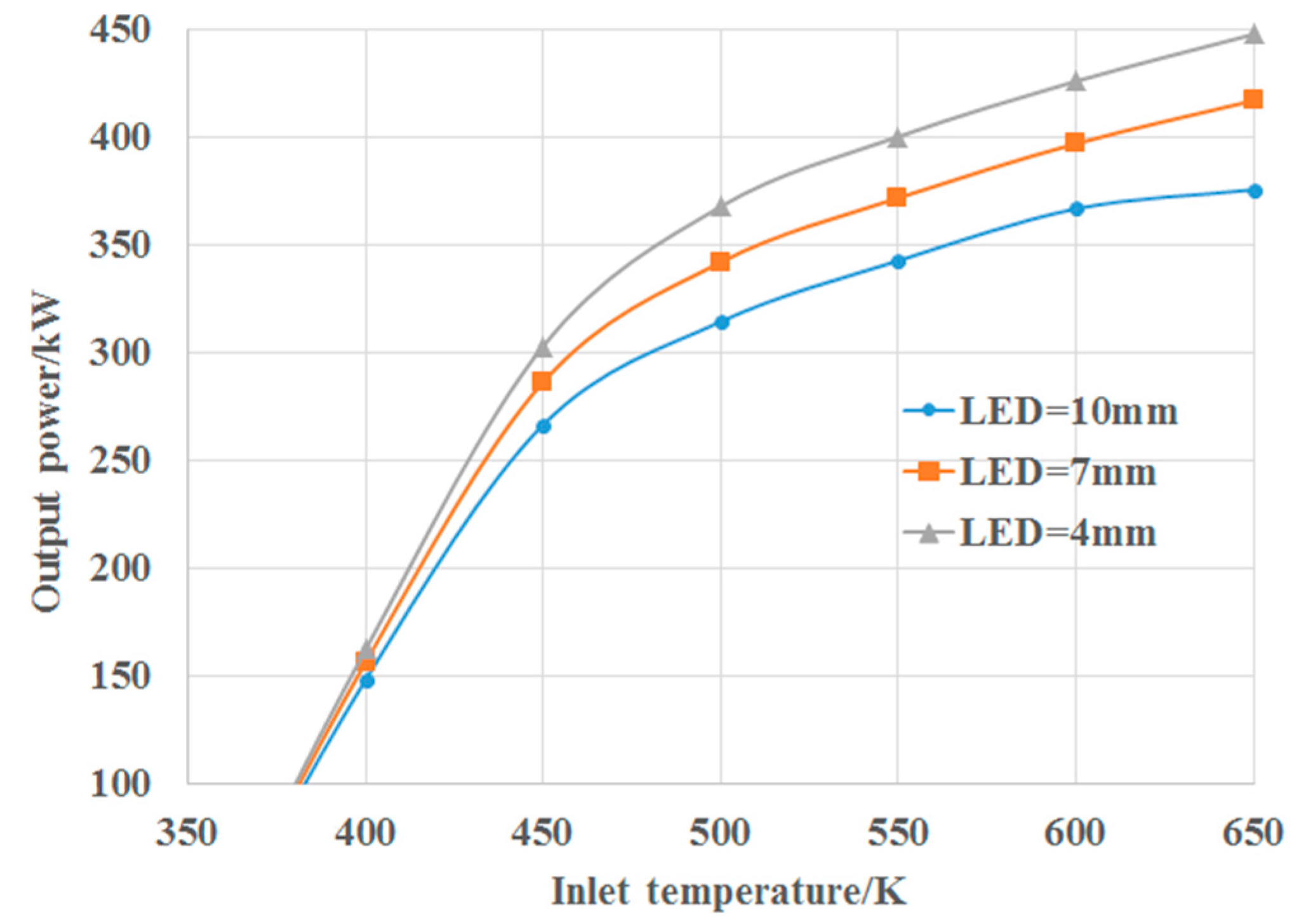
| Parameter | Value |
|---|---|
| Blade number | 10 |
| Diameter of impeller (mm) | 92.2 |
| Inlet blade height (mm) | 2.97 |
| External diameter of outlet (mm) | 40.6 |
| Inner Diameter of outlet (mm) | 16 |
| Outlet blade angle (°) | 27 |
| Axial length (mm) | 20 |
| Impeller type | shrouded |
| Parameter | Value |
|---|---|
| Blade number | 13 |
| Outlet diameter (mm) | 136.2 |
| Inlet diameter (mm) | 104.2 |
| Blade height (mm) | 2.97 |
| Inlet blade angle (°) | 45 |
| Outlet blade angle (°) | 10 |
| Sequence Number | Total Element Number/104 | Output Power/kW | Relative Error/% |
|---|---|---|---|
| 1 | 4.2 | 324.5 | / |
| 2 | 16.9 | 339.2 | 4.33 |
| 3 | 31.4 | 342.7 | 1.02 |
| 4 | 48.6 | 341.6 | −0.32 |
© 2018 by the authors. Licensee MDPI, Basel, Switzerland. This article is an open access article distributed under the terms and conditions of the Creative Commons Attribution (CC BY) license (http://creativecommons.org/licenses/by/4.0/).
Share and Cite
Zhang, D.; Wang, Y.; Xie, Y. Investigation into Off-Design Performance of a S-CO2 Turbine Based on Concentrated Solar Power. Energies 2018, 11, 3014. https://doi.org/10.3390/en11113014
Zhang D, Wang Y, Xie Y. Investigation into Off-Design Performance of a S-CO2 Turbine Based on Concentrated Solar Power. Energies. 2018; 11(11):3014. https://doi.org/10.3390/en11113014
Chicago/Turabian StyleZhang, Di, Yuqi Wang, and Yonghui Xie. 2018. "Investigation into Off-Design Performance of a S-CO2 Turbine Based on Concentrated Solar Power" Energies 11, no. 11: 3014. https://doi.org/10.3390/en11113014




